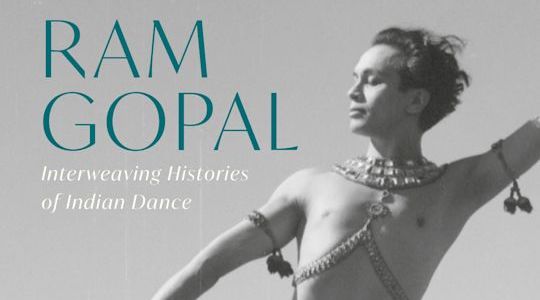Book: Ram Gopal: Interweaving Histories of Indian Dance
Author: Ann R. David, Bloomsbury Publishing, February 2024.
Ann R. David’s Ram Gopal: Interweaving Histories of Indian Dance is a fascinating, very detailed, extensively researched book that details the life and times of famous Indian dancer Ram Gopal (1912-2003) and how he influenced and changed the view of dance for decades. He performed widely during the 1930s-60s and, along with Uday Shankar, was included among the first artists to present works of Indian classical dance to Western audiences. Much is made of the cross-fertilization between Indian dance and in particular ballet, but also ‘modern’ dance (e.g. Laban and Wigman). Also his inspiring by other artists paintings, drawings, sculpture, film and TV and other arts. It is of medium size and thickness, divided into six sections, with an index, bibliography, appendixes and some photos (some in colour, most black and white).
It is not specifically written chronologically, but rather each of the sections takes a particular item and uses it as a base to discuss further (e.g. Gopal’s passport, or his glorious Siva head dress). It is both a biography and a history. David examines both the dancer and individual, who had incredible charisma, utilizing extensive interviews with his fellow dancers, friends, dance partners/members of his company, costume makers, and recollections by audience members. David places the culture of Indian dance of the era in context, and there is scholarly examination of the tense politics of the naming of the style(s) of dance and the major changes with the dissolution of colonialism, the patriotic feeling of belonging to both Britain and India, and how ‘modern’ dance and ballet influenced the expansion, styles and audiences of Indian dance.
The book touched on Gopal’s private life. He was gay but had to stay ‘in the closet‘ and was rather fleetingly married in the 1960s, while living in Chelsea, London to Edith Alexander, although the marriage ended only a few years later with her death. The couple had no children.
David reveals details of Gopal’s family, parents (he was the son of a Rajput lawyer father and a Burmese mother), siblings, etc growing up, his early dance training and short performing career in India, the first international tours that saw sell-out performances and glowing reviews in the USA and in London before and during World War 11. Gopal’s return and touring in India during World War II is discussed, as are the international performances and tours afterward.
David also surveys the opulent imagery of Gopal taken by celebrity photographers such as Cecil Beaton and Carl Van Vechten, authors such as Cyril Beaumont and distinguished artists such as Kay Ambrose, Milein Cosman and Felix Topolski, and what this meant about the possible but obvious homoerotic gaze of the viewer, the era’s fixation with his body and the way Indian dancers of the era were regarded. She also details Gopal’s relationships with assorted impressarios/presenters (e.g. Sol Hurok).
Gopal moved to London in the 1950s, where apart from tours he remained, and became great friends with Alicia Markova and Anton Dolin, performing with Markova and the Harlequin Ballet Dance Company. He attempted to establish a dance school, but it fizzled out.
In the 1980s, Gopal became very frail and, while still keeping up with things in the dance world, entered a nursing home. In 1999, he was awarded an O.B.E. He died in London, on 12 October 2003, aged 90.
This is a vital, vibrant, much needed investigation of a now rather overlooked but very important person in the history of the dance world.
By Lynne Lancaster of Dance Informa.













